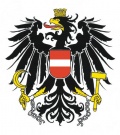Regulation of civic coats of arms in Austria
Austria heraldry portal
This page is part of the Austria heraldry portal |
Heraldry of the World |
|
Civic heraldry:
|
Other heraldry: |
REGULATION OF CIVIC ARMS IN AUSTRIA
Personal coats of arms are forbidden by an Act of law out of 1919. This Act is of constitutional rank. Breaking the law means a fine or six weeks imprisonment.
Civic coats of arms are allowed and may be granted by the states; well, some do not exercise this prerogative. Vorarlberg has no need to, because all municipalities in the state have had coats of arms for about 30 years.
Vienna does not exercise this right, neither, because the only municipality within the state of Vienna is the city of Wien, which has borne arms since the 13th century.
In the other Austrian states, the procedure of granting arms is laid down in the Gemeindeordnung (State Law governing the Structure, Rights and Duties of municipalities). Municipalities may apply for a grant of a coat of arms.
Usually, the coat of arms will be devised by the Landesarchiv (State Archives) and granted by the Landesregierung (Government of the State). Usually, the grant is written out twice. One of these illuminated letters patent will be handed to the Buergermeister (Mayor) of the municipality, usually with some kind of ceremony and celebration. The other letters patent will be placed in the Landesarchiv.
In Styria, the texts of grants are also published in the Landesgesetzblatt (State Gazette). The coats of arms, however, are not published there, because of the cost. The text of a grant, the coat of arms, a short history of the region of the now armigerous municipality and a brief explanation of the coat of arms are published in the annual Mitteilungen des Steiermärkischen Landesarchivs (MStLA). Of late, however, it has happened that the publication of grants in the MStLA takes two or three years (printing costs).
Contact and Support
Partners:
Your logo here ?
Contact us
© since 1995, Heraldry of the World, Ralf Hartemink 
Index of the site
Literature :Information provided by H. Hayn











